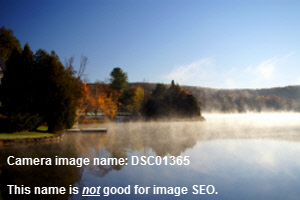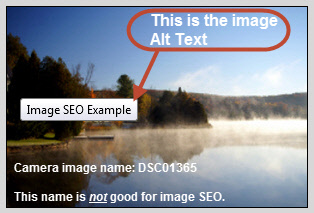Content Marketing and Images
 Image SEO & Content Marketing
Image SEO & Content Marketing
Image SEO (Search Engine Optimization)
Images are very important to your content and content marketing in multiple ways.
Images have a multitude of uses on a website.
They can be used as:
- Navigational buttons
- Bullet points
- Mixed together with text to add some spice and to engage
- Places to focus the attention of the reader
And more . . .
Images and graphics are an important part of content marketing planning and implementation and can aid your SEO. Great imagery and graphics can help to win the day with your search engine visitors.
Most visitors to a website will be able to interpret and understand the images simply by looking at them. But did you know that a search engine cannot “see” the image or graphic. These important visitors to your website (the search engines) need help to understand the meaning of any image. What can you do to help a search engine to understand your images? Remember if you help them then they can help you by placing you higher in their search results?
Hyper Text Mark-up Language (HTML) — the functional code of the Internet — allows you to add a textual description of the images so they can be “read” by search engines. This is done through the alt attribute. Now I want to be clear that I am not trying to make anyone who blogs or creates content for a website to be an expert in HTML – by no means! I simply want to provide a bit more image SEO support to anyone who may be adding an image or a graphic to their blog post or website page.
Here is some advice:
Image SEO – Image File Names
Name your image with a file name that relates to the content on the page or blog post. I see many examples of an image being placed on a page with the image file name the name that the camera called it. Here is an example of an image file name from my camera. The camera called this lovely picture of a lake near my home DSC01365. This is a fine name as far as the camera is concerned but as far as a search engine is concerned it is not at all helpful to providing insight into the visual content of the image.
 Help the search engine to understand and you will benefit. For good image SEO name your images what they really are and also select a name that relates well to the page where the image will be presented. Use hyphens to separate the individual words. For this example the image file name could be “Barnard-VT-Silver-Lake.jpg”.
Help the search engine to understand and you will benefit. For good image SEO name your images what they really are and also select a name that relates well to the page where the image will be presented. Use hyphens to separate the individual words. For this example the image file name could be “Barnard-VT-Silver-Lake.jpg”.
Image SEO and/or Graphics SEO
I know quite a few excellent graphic artists that do fantastic work from a graphic artist perspective. However, they may provide graphics for a website with file names such as Header or Logo. These are fine names from the perspective of the graphic artist but they do not help a search engine to understand the content.
Have your website designer, graphic artist and search engine optimization consultant work together to help the search engines to understand the content value of the graphic or image and you will benefit. Even doing simple thing such as calling your logo “company-name-logo.jpg” instead of just “logo” will help.
Image SEO – Behind the Scenes – Alt Text
All of your on-page graphics can have a snippet of text called alt text. This text sits behind the image and guess what . . . a search engine can read this text. The search engine associates the alt text with the image and therefore the alt text provides insights to the search engine as to what the image or graphic may be about.
Here is an example of alt text can be used with an image:
<img src=www.mywebsite/Image-SEO-Alt-Text.jpg alt=”Image SEO – Alt Text”>

The image alt attribute is an important tool for search engine optimization (SEO). It also allows search engine crawlers to understand what the images represent, which to achieve a higher position in the search results.
Also, the major search engines realize that this adds an additional layer of usability for people and the search engines want to provide the best possible experience for people so an added layer of usability counts for even more points with the search engines.
The alt text is the text that appears over the images on a website page when you place your mouse over the image.
Image SEO – Final Thoughts and Advice
Use the following image formats when saving images for the web – gif, jpeg or png.
When saving an image use a file name that is descriptive of the image and not a generic file name such as DSC221069.jpg.
Reduce the image file size to be a small as possible while not degrading the image quality. Search engines like fast load times as this improves the human experience and as noted above the customers of the search engines are humans so you can be sure that they want to keep their customers happy.
Search engine crawlers normally index images of all sizes, but getting the file size down as small as possible will help with the page loading time and will enhance the visitor user experience. This can be done by reducing the physical size of the image and reducing the number of colors used by the image with the help of image manipulation software.
Specify the width and height of the image within the HTML. This tells a web browser the dimensions of the image before it has loaded and space will be reserved for it. This prevents the elements on a page from jumping around while it downloads. Most modern website and blog content management system (CMS) do this automatically. Use a capable CMS (content management system) to ensure this.
If you have text that is important in terms of relevancy to the website or SEO, do not embed it within an image, make sure it can be read as text and is part of the normal content on the page. The “normal” content can read by the search engines.
Image alt text must be descriptive and try to keep total length to less than ten words.
For SEO purposes you should try to include keywords within the alt attribute, but avoid keyword stuffing. For example, if you were showing men’s watches; this is an example of incorrect alt text usage:
<img src=”http://www.mywebsite/images /menswatches.jpg” alt=”mens watches, watches for men, watches men, men watches”>
Don’t do this!
If your website has a number of images showing men’s watches, make sure the alt text is different for each image. Try to include the model of the watch or the color or some other keyword phrase description attribute.
Where a company logo is displayed, it is good practice to use a great keyword phrase and your company name.
By improving the content of your website or blog with the correct use of the image file names and the alt text attribute coupled with image file size optimization (for fast page load times) you will enhance your visitors’ experience which impacts on your site’s overall SEO in a positive way.
If you want to learn more about content marketing or SEO – including image SEO – then I encourage you to explore this website further by visiting our tutorials on Content Marketing and visit our blog which is dedicated to search engine optimization and content marketing.
SEO Notebook (our blog)
Introduction to Content Marketing (the 1st part of an entire tutorial series on content marketing)
Enjoy!
